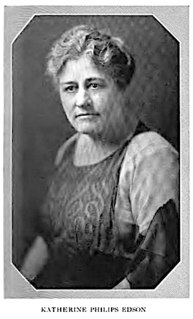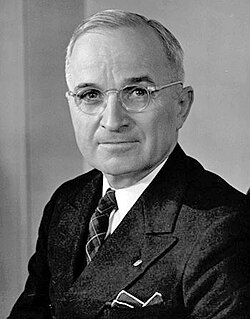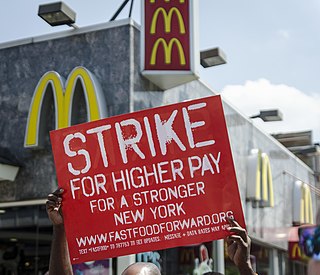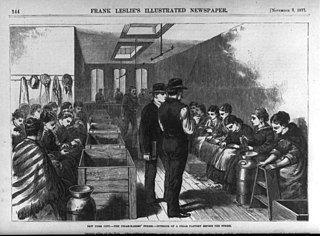Labour law mediates the relationship between workers, employing entities, trade unions and the government. Collective labour law relates to the tripartite relationship between employee, employer and union. Individual labour law concerns employees' rights at work also through the contract for work. Employment standards are social norms for the minimum socially acceptable conditions under which employees or contractors are allowed to work. Government agencies enforce labour law.

Sweatshop is a pejorative term for a workplace that has very poor, socially unacceptable working conditions. The work may be difficult, dangerous, climatically challenged or underpaid. Workers in sweatshops may work long hours with low pay, regardless of laws mandating overtime pay or a minimum wage; child labor laws may also be violated. The Fair Labor Association's "2006 Annual Public Report" inspected factories for FLA compliance in 18 countries including Bangladesh, El Salvador, Colombia, Guatemala, Malaysia, Thailand, Tunisia, Turkey, China, India, Vietnam, Honduras, Indonesia, Brazil, Mexico, and the US. The U.S. Department of Labor's "2015 Findings on the Worst Forms of Child Labor" found that "18 countries did not meet the International Labour Organization's recommendation for an adequate number of inspectors."
Collective bargaining is a process of negotiation between employers and a group of employees aimed at agreements to regulate working salaries, working conditions, benefits, and other aspects of workers' compensation and rights for workers. The interests of the employees are commonly presented by representatives of a trade union to which the employees belong. The collective agreements reached by these negotiations usually set out wage scales, working hours, training, health and safety, overtime, grievance mechanisms, and rights to participate in workplace or company affairs.

The labor history of the United States describes the history of organized labor, US labor law, and more general history of working people, in the United States. Beginning in the 1930s, unions became important components of the Democratic Party. Some historians question why a Labor Party did not emerge in the United States, in contrast to Western Europe.

The American Railway Union (ARU) was briefly among the largest labor unions of its time and one of the first industrial unions in the United States.
A lockout is a work stoppage or denial of employment initiated by the management of a company during a labor dispute. In contrast to a strike, in which employees refuse to work, a lockout is initiated by employers or industry owners. Lockouts are usually implemented by simply refusing to admit employees onto company premises, and may include changing locks or hiring security guards for the premises. Other implementations include a fine for showing up, or a simple refusal of clocking in on the time clock. For these reasons, lockouts are referred to as the antithesis of strikes.
Finnish national income policy agreements or comprehensive income policy agreements are tripartite agreements between Finnish trade unions, employers' organizations, and the Finnish government. They are policy documents covering a wide range of economic and political issues, such as salaries, taxation, pensions, unemployment benefits, and housing costs. They represent collective bargaining taken to its logical maximum, reaching virtually all wage-earners. Their enforcement is made easier by the universal validity of collective labour agreements. However, they are voluntary agreements and are not considered government legislation, i.e. they do not represent central planning of the economy.
Labor rights or workers' rights are a group of legal and human rights relating to labor relations between workers and employers, codified in national and international labor and employment law. In general, these rights influence working conditions in relations of employment. One of the most central is the right to freedom of association, otherwise known as the right to organize. Workers organized in trade unions exercise the right to collective bargaining to improve working conditions.

The Coal strike of 1902 was a strike by the United Mine Workers of America in the anthracite coalfields of eastern Pennsylvania. Miners struck for higher wages, shorter workdays and the recognition of their union. The strike threatened to shut down the winter fuel supply to major American cities. At that time, residences were typically heated with anthracite or "hard" coal, which produces higher heat value and less smoke than "soft" or bituminous coal.

The Great Railroad Strike of 1922, commonly known as the Railway Shopmen's Strike, was a nationwide strike of railroad workers in the United States. Launched on July 1, 1922, by seven of the sixteen railroad labor organizations in existence at the time, the strike continued into the month of August before collapsing.

Labor unions in the United States are organizations that represent workers in many industries recognized under US labor law. Their activity today centers on collective bargaining over wages, benefits, and working conditions for their membership, and on representing their members in disputes with management over violations of contract provisions. Larger trade unions also typically engage in lobbying activities and electioneering at the state and federal level.

Katherine Philips Edson was an American reformer and social activist who had a key role in changing the labor conditions in California and across the nation.
Opposition to trade unions comes from a variety of groups in society and there are many different types of argument on which this opposition is based.
The U.S. Steel recognition strike of 1901 was an attempt by the Amalgamated Association of Iron, Steel and Tin Workers to reverse its declining fortunes and organize large numbers of new members. The strike failed.

The minimum wage in the United States is set by US labor law and a range of state and local laws. Employers generally have to pay workers the highest minimum wage prescribed by federal, state, and local law. Since July 24, 2009, the federal government has mandated a nationwide minimum wage of $7.25 per hour. As of January 2018, there were 29 states with a minimum wage higher than the federal minimum. From 2017 to 2018, eight states increased their minimum wage levels through automatic adjustments, while increases in eleven other states occurred through referendum or legislative action.

The 1952 steel strike was a strike by the United Steelworkers of America against U.S. Steel and nine other steelmakers. The strike was scheduled to begin on April 9, 1952, but President Harry S Truman nationalized the American steel industry hours before the workers walked out. The steel companies sued to regain control of their facilities. On June 2, 1952, in a landmark decision, the United States Supreme Court ruled in Youngstown Sheet & Tube Co. v. Sawyer, 343 U.S. 579 (1952), that the president lacked the authority to seize the steel mills. The Steelworkers struck to win a wage increase. The strike lasted 53 days, and ended on July 24, 1952, on essentially the same terms the union had proposed four months earlier.
The Sons of Vulcan was an American labor union which existed from 1858 until 1876. The union recruited puddlers, skilled craftsmen who manipulated pig iron to create steel. In the 1870s, it was the strongest union in the United States. It merged with two other iron and steel unions in 1876 to form the Amalgamated Association of Iron and Steel Workers—the forerunner of the United Steelworkers.

The Davis–Bacon Act of 1931 is a United States federal law that establishes the requirement for paying the local prevailing wages on public works projects for laborers and mechanics. It applies to "contractors and subcontractors performing on federally funded or assisted contracts in excess of $2,000 for the construction, alteration, or repair of public buildings or public works".

The Fight for $15 is an American political movement advocating for the federal minimum wage to be raised to $15 per hour. The federal minimum wage was set at $7.25 per hour in 2009, and as of 2019 it has not been increased since. The movement has involved strikes by child care, home healthcare, airport, gas station, convenience store, and fast food workers for increased wages and the right to form a labor union. The "Fight for $15" movement started in 2012, in response to workers' inability to cover their costs on such a low salary, as well as the stressful work conditions of many of the service jobs which pay the minimum wage.

The Cigar makers strike of New York lasted from mid-October 1877 until mid-February 1878. Ten thousand workers walked out at the height of the strike, demanding better wages, shorter hours and better working conditions, especially in the tenement manufacturing locations. The strike was supported by the Cigar Makers International Union of America, local chapter 144.













